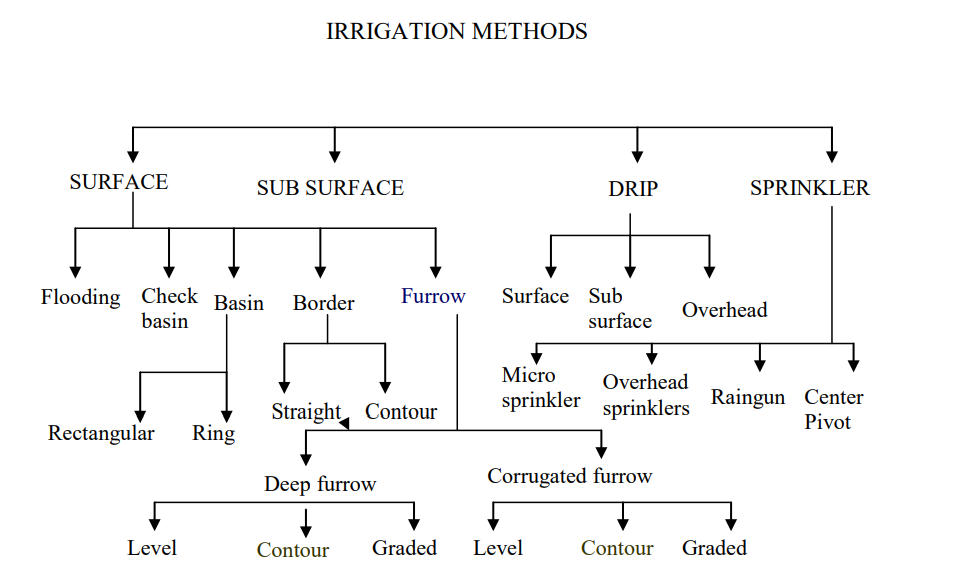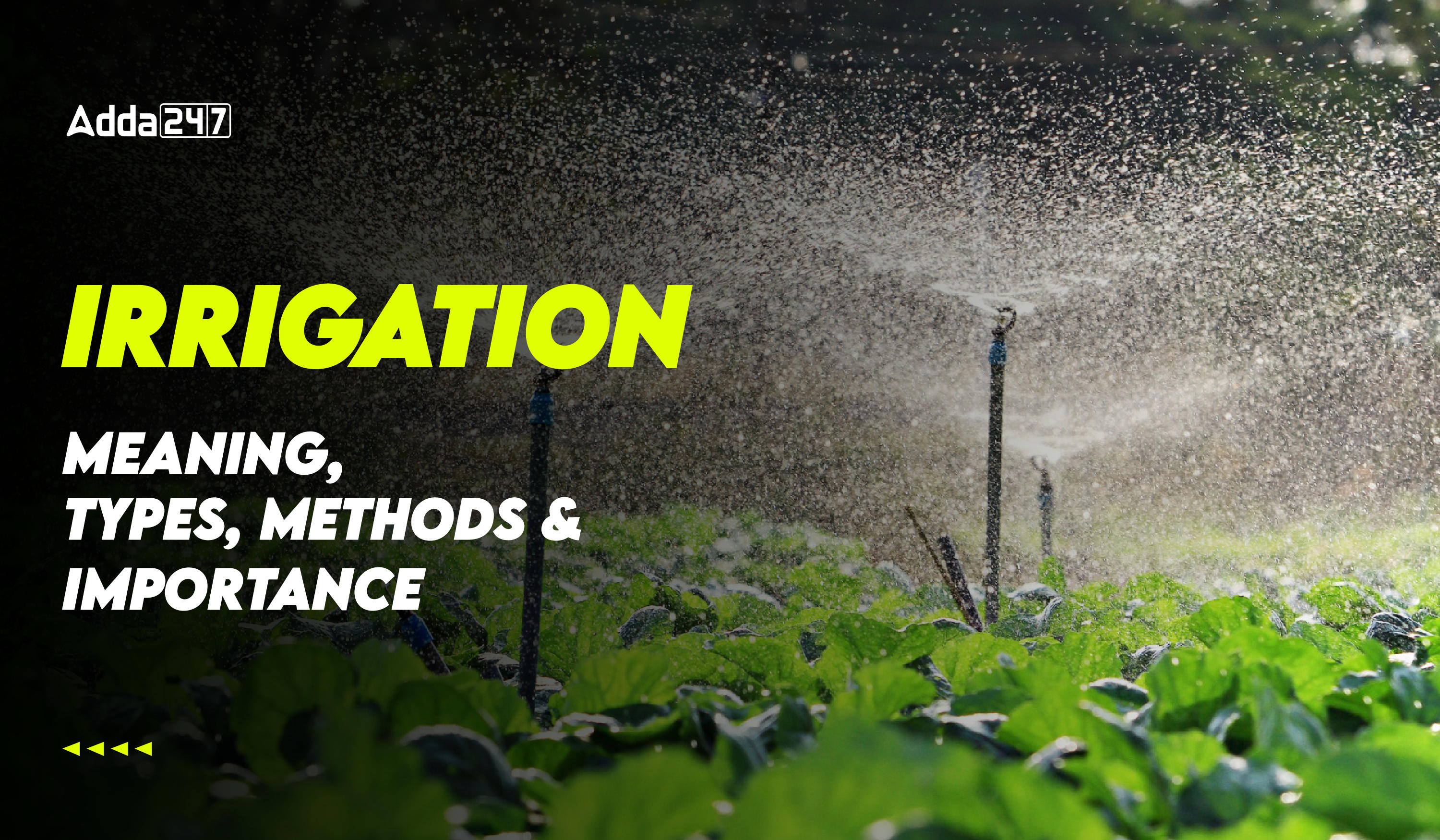Table of Contents
Irrigation, an important practice in agriculture, involves the application of water to soil to enhance crop production beyond natural rainfall and groundwater availability. This strategic use of water resources plays a critical role in ensuring agricultural productivity and sustainability in regions where climatic conditions alone may not support sufficient plant growth. By supplementing natural water sources with controlled irrigation methods, farmers can manage moisture levels effectively, reduce risks posed by unpredictable weather patterns, and ultimately contribute to global food security.
Let’s learn about irrigation, its different times, methods, and modern techniques of irrigation in this article. As agriculture continues to evolve to meet growing food demands, irrigation remains indispensable in supporting crop yields and livelihoods worldwide.
Irrigation
Irrigation is defined as the artificial application of water to the soil for crop production in supplement to rainfall and groundwater contribution. Importance of water to plants
- Plants contain 90% water which gives turgidity and keeps them erect.
- Water is an essential part of protoplasm.
- It regulates the temperature of the plant system.
- It is essential to meet the transpiration requirements.
- It serves as a medium for dissolving the nutrients present in the soil.
- It is an important ingredient in photosynthesis.
Time of Irrigation
Crops draw water from the moisture stored in the soil. When the moisture present in the soil is low, then the plant requirements are not met. When the soil is supplied with moisture in excess the supply of air is reduced which limits the plant’s growth. In between, there is a range of moisture content that is called as optimum soil moisture range for plant growth.
The upper limit of the optimum soil moisture range is the field capacity (-0.01 to -0.03 Mpa) and the lower limit is just above the wilting point (-1.5 Mpa). The objective of irrigation is to store the moisture in the soil between these limits. Immediately after irrigation, all the macro and micropores will be filled with water. All the water present in macropores will drain to subsoil within 48 hours and moisture in micropores will be available to plants.
As the soil dries due to loss of water by evaporation and transpiration, the plant wilts during the daytime to conserve moisture and become normal at night. When the same condition continues, the plant will wilt without dying. This condition is called the wilting coefficient. Irrigation is given whenever plants require water. This is decided by the crop and soil appearance.
Different types of Irrigation methods
Irrigation methods like surface, sub-surface, and pressurized systems are crucial for helping crops grow well and saving water on farms. They work in different ways to suit different landscapes and types of crops, which is important for sustainable farming as we face challenges like water shortages and increased food needs worldwide.
Criteria for selection of irrigation method
- Water supply source
- Topography
- Quantity of water to be applied
- The crop
- Method of cultivation

Surface irrigation methods
The oldest (4000 years back) and most common method. 90% of the world’s total irrigated area is under this method. In the USA also, 66% is by surface irrigation.
- This method is most suitable for low to moderate infiltration rates and leveled lands having <2-3% slope.
- It is labor intensive.
- The surface is grouped as Border, check basin, and furrow irrigations.
- The border is again classified into two straight and contour.
- Check basins may be rectangular, contour, or ring, furrow irrigation is classified as deep furrow and corrugated furrows.
- These may be again straight or contour according to direction and leveled and graded as per their elevation
Border Irrigation
The land is divided into several long parallel strips called borders. These borders are separated by low ridges. The border strip has a uniform gentle slope in the direction of irrigation. Each strip is irrigated independently by turning the water in the upper end. The water spreads and flows down the strip in a sheet confined by the border ridges.
Suitability: Border irrigation works well for soils with moderate water absorption rates. It’s not ideal for very sandy soils that absorb water quickly or heavy soils that absorb water slowly. It’s suitable for crops like wheat, barley, fodder crops, and legumes, but not for rice.
Advantages
- Border ridges can be made using simple tools like bullock-drawn ridges.
- It requires less labor compared to traditional check basin methods.
- Water can be distributed evenly, leading to high efficiency.
- It’s effective for irrigating larger areas.
- It provides good surface drainage if there are outlets available.
Check basin Irrigation
Check basin irrigation is a widely used method where fields are divided into smaller sections with nearly level surfaces. Bunds or ridges are built around these sections to form basins, allowing control over irrigation water. Water is applied to a desired depth and retained within the basin until it infiltrates into the soil. Basin sizes typically range from 10 m² to 25 m², depending on factors such as soil type, terrain, water availability, and the type of crop being cultivated.
Adaptability: Check basin irrigation is suitable for gentle slopes and soils with moderate to low infiltration rates. It works well with grain and fodder crops in heavy soils and is also suitable for permeable soils.
Advantages
- Check basins are effective for leaching salts from the soil profile.
- They conserve rainfall and reduce soil erosion by retaining a significant amount of rainwater.
- High water application and distribution efficiency can be achieved.
Limitations
- Ridges created by check basins can hinder the movement of farming equipment.
- More land area is taken up by ridges and field channels.
- Check basin irrigation can impede surface drainage.
- Precise land grading and shaping are necessary for effective implementation.
- It requires more labor compared to other irrigation methods.
- Not suitable for crops that are sensitive to wet soil conditions around the stem.
Furrow Irrigation
Furrow irrigation is used primarily for row crops, where furrows are created between crop rows. The dimensions of furrows vary based on the crop, equipment used, and soil type. Water is applied through small streams that run in the furrows, allowing it to infiltrate the soil and spread laterally to wet the area between the furrows. In heavy soils, furrows can also help drain excess water.
Adaptability
- Suitable for wide-spaced row crops, including vegetables.
- Ideal for crops like maize, sorghum, sugarcane, cotton, tobacco, groundnut, and potatoes.
- Works well in most soils except sandy soils.
Advantages
- Water in furrows only contacts about 1/2 to 1/5 of the land surface, minimizing water use.
- Reduces labor required for land preparation and irrigation compared to other methods.
- Less land is wasted in field ditches compared to check basins.
Surge Irrigation
Surge irrigation is the application of water into the furrows intermittently in a series of relatively short ON and OFF times of the irrigation cycle.
- It has been found that intermittent application of water reduces the infiltration rate over surges thereby the waterfront advances quickly. Hence, reduced net irrigation water requirement.
- This also results in more uniform soil moisture distribution and storage in the crop root zone compared to continuous flow.
- The irrigation efficiency is between 85 and 90%.
Sub-Surface Irrigation
Subsurface irrigation involves applying water beneath the ground by maintaining an artificial water table typically 30-75 cm below the surface. Moisture moves upwards through capillary action towards the land surface. Water is distributed through underground field trenches spaced 15-30 meters apart, often using open ditches due to their cost-effectiveness and suitability for all soil types. High-quality irrigation water is essential to prevent soil salinity.
Advantages
- Requires minimal water for crop growth.
- Reduces evaporation and deep percolation losses.
- Maximizes land use efficiency without wastage.
- Does not interfere with farm machinery movement.
- Allows cultivation operations without concern for irrigation timing.
Disadvantages
- Requires specific natural conditions for optimal performance.
- Risk of waterlogging if drainage is inadequate.
- Potential for underground pipe clogging.
- Initial installation costs are relatively high.
Subsurface irrigation offers efficient water use and operational flexibility but requires careful management of soil conditions and water quality to avoid potential drawbacks such as waterlogging and maintenance issues.
Pressurized or Modern Irrigation System
Modern irrigation systems, also called pressurized systems, are advanced ways of watering crops efficiently. These systems, like drip irrigation, use technology to deliver water precisely to plants’ roots, helping manage challenges such as water scarcity and salty soil. They include pumps, pipes, and small outlets that control water flow. These systems save water, can be adjusted to fit different landscapes, and may lower energy use. However setting them up needs planning, knowledge, and ongoing care to work well in different farming conditions.
Drip Irrigation System
Drip irrigation, also known as trickle irrigation, is a modern and efficient method designed especially for areas with water scarcity and salt-affected soils. This system delivers water directly to the root zone of crops, minimizing water loss and maximizing efficiency. Proper water quality testing is essential for its effective design and operation.
Components of Drip Irrigation
- Main Components: Includes a pump or overhead tank, mainline, sub-mains, laterals, and emitters.
- Water Distribution: The mainline carries water to sub-mains, which are distributed through laterals equipped with emitters.
- Materials: The main and sub-mains are typically PVC pipes, while laterals are made from LLDPE tubes. Emitters are also made from PVC.
- Additional Components: Pressure regulators, filters, valves, water meters, and devices for fertilizer application are integral for proper system function.
Advantages of Drip Irrigation
- High Water Use Efficiency: Approximately 95%, compared to less than 50% in surface irrigation methods.
- Flexible Wetted Area: Allows precise water application directly to the plant roots.
- Emitter Versatility: Offers a variety of emitter types, discharge rates, and positions to suit different crop and soil conditions.
- Weed Control Economy: Reduces weed growth by limiting water to specific areas.
- Minimal Interference: Does not disrupt cultivation activities.
- 24/7 Operation: Enables irrigation at any time, day or night.
- Leaf Wetting Prevention: This helps prevent disease by keeping foliage dry.
- Energy Savings: Uses less energy compared to other irrigation methods.
- Salinity Control: Manages soil salinity levels effectively.
- Adaptable to Terrain: Suitable for various topographical conditions.
Limitations of Drip Irrigation:
- High Initial Investment: Requires significant upfront costs.
- Technical Knowledge: Needs expertise for optimal and cost-effective operation.
- Mechanical Vulnerability: Susceptible to damage from equipment and external factors.
- Maintenance: Requires frequent checks and upkeep of emitters, filters, and controls.
- Extended Application Time: Takes longer to apply water compared to other methods.
- Filtration Needs: Demands high-quality filtration to prevent clogging.
Sprinkler Irrigation System
Sprinkler irrigation mimics rainfall by distributing water overhead through sprinklers. This pressurized system uses pipes (usually aluminum or PVC) and nozzles to evenly deliver water across fields, ensuring uniform coverage that surface irrigation can’t achieve. Water is applied at a rate slower than the soil’s ability to absorb it, reducing runoff.
Types of Sprinkler Systems
- Rotating Head (Revolving Sprinkler System): Sprinklers rotate to cover large areas.
- Perforated Pipe System: Pipes with holes distribute water uniformly.
Classification by Portability
- Portable System: Easily moved for different fields.
- Semi-permanent System: This can be relocated with some effort.
- Solid Set System: Fixed in place but can cover large areas.
- Permanent System: Stationary and covers specific fields permanently.
Advantages of Sprinkler Irrigation
- Suitable for Sloped Terrain: Works well on uneven land.
- Water Conservation: Saves 35-40% compared to surface methods.
- Fertilizer Application: Allows fertilizers and chemicals to be applied with water, reducing waste.
- Erosion Reduction: Minimizes soil erosion.
- Ideal for Sandy Soils: Effective on coarse-textured soils.
- Frost Protection: Guards crops from frost and extreme temperatures.
- Drainage Improvement: Helps manage excess water.
- Space Efficiency: Saves land compared to surface irrigation.
Limitations
- High Initial Cost: Requires significant investment.
- Wind Sensitivity: Efficiency can be affected by wind.
- Evaporation Losses: Higher water loss through evaporation.
- Crop Suitability: Not suitable for tall crops like sugarcane.
- Clay Soils: Ineffective on heavy clay soils.
- Water Quality: Sensitive to poor water quality, which can clog nozzles and harm crops sensitive to salt.




 RRB Paramedical Admit Card 2025 Out, Che...
RRB Paramedical Admit Card 2025 Out, Che...
 KGMU Nursing Officer Recruitment 2025, A...
KGMU Nursing Officer Recruitment 2025, A...
 Punjab Police Constable Exam Date 2025, ...
Punjab Police Constable Exam Date 2025, ...


 Adda247 Job portal has complete information about all Sarkari Jobs and Naukri Alerts, its latest recruitment notifications, from all state and national level jobs and their updates.
Adda247 Job portal has complete information about all Sarkari Jobs and Naukri Alerts, its latest recruitment notifications, from all state and national level jobs and their updates.